Geochemical & Rock Analysis
-
Elemental Analysis
-
W.M. Keck Isotope Laboratory
-
Microscopy and Imaging
-
Rock Preparation
-
Stable Isotope Laboratory
-
Geochronology
-
X-ray Diffraction
-
Laser Diffraction Particle Analysis
Elemental Analysis
The Earth & Planetary Sciences Department at UC Santa Cruz maintains a complete set of tools with which to measure elemental composition. Energy dispersive X-Ray spectroscopy (EDS) is used to measure all elements in the periodic table above beryllium additionally for spatially-resolved analyses of these elements. Trace and ultra-trace concentration measurements in both solids and liquids are performed inductively-coupled mass spectrometry (ICPMS), both quadrupole-based and high-resolution magnetic sector instruments. Additionally, through the Institute of Marine Sciences lab in our building, we have access to inductively-coupled optical emission spectroscopy (ICPOES), atomic absorption spectrophotometry, ion chromatography, gas chromatography, and gas chromatograph mass spectrometry.
- Inductively-coupled Plasma Mass Spectrometry: In the spring of 2009 a new plasma analytical facility was established to replace our 15 year old Element 1 (the first of its kind in an academic lab in the U.S.). The new facility includes a Thermo Element XR (extended range) magnetic sector high-resolution ICPMS, an X-series quadrupole ICPMS, a Photon Machines Analyte 193H excimer laser system and Zygo NewView
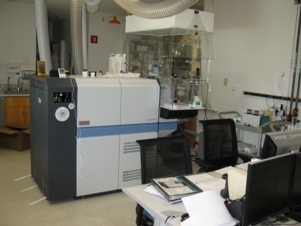 7200 Vertical Scanning Interferometer (for inspecting laser ablation pits). Combined with our complete suite of plasma introduction systems (desolvating nebulizers, flow injection system, Peltier-cooled spray chambers, etc.), we are equipped to measure most of the periodic table, over a wide range of concentrations, in solids and liquids of a wide range of compositions. A diverse user group includes marine chemists, igneous geochemists, archaeologists, inorganic chemists, geochronologists, environmental toxicologists, and paleo-oceanographers, to name a few.
7200 Vertical Scanning Interferometer (for inspecting laser ablation pits). Combined with our complete suite of plasma introduction systems (desolvating nebulizers, flow injection system, Peltier-cooled spray chambers, etc.), we are equipped to measure most of the periodic table, over a wide range of concentrations, in solids and liquids of a wide range of compositions. A diverse user group includes marine chemists, igneous geochemists, archaeologists, inorganic chemists, geochronologists, environmental toxicologists, and paleo-oceanographers, to name a few.
W.M. Keck Isotope Laboratory
 Projects covering earth sciences, marine sciences, ecology, environmental science and toxicology, biogeochemistry, and archaeology frequently use the W.M. Keck Isotope Laboratory facilities for high precision isotope measurements. Both UCSC and non-UCSC scientists are invited to use the facilities. The W.M. Keck Isotope Laboratory comprises both TIMS and MC-ICP-MS mass spectrometers and well-appointed wet chemical facilities all housed in recently refurbished class 1000 suite of clean labs. For more information on the facilities available and use of the facilities contact Terry Blackburn
Projects covering earth sciences, marine sciences, ecology, environmental science and toxicology, biogeochemistry, and archaeology frequently use the W.M. Keck Isotope Laboratory facilities for high precision isotope measurements. Both UCSC and non-UCSC scientists are invited to use the facilities. The W.M. Keck Isotope Laboratory comprises both TIMS and MC-ICP-MS mass spectrometers and well-appointed wet chemical facilities all housed in recently refurbished class 1000 suite of clean labs. For more information on the facilities available and use of the facilities contact Terry Blackburn
Scanning Electron Microscopy 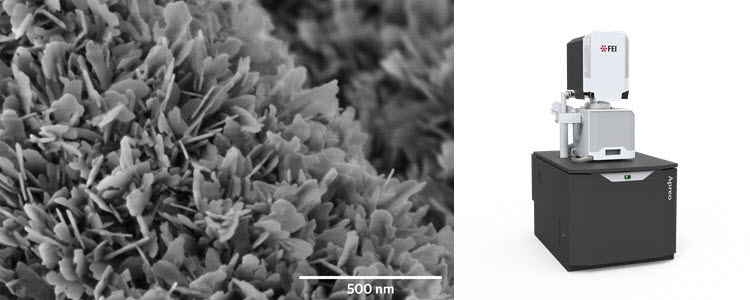
The Earth and Planetary Sciences Department has a Thermo Scientific Apreo scanning electron microscope (SEM) The SEM is high/low-vacuum compatible and capable of beam currents up to 400 nA. It is equipped for secondary electron (SE), backscattered electron (BSE), electron backscatter diffraction (EBSD), cathode luminescence (CL) and energy dispersive X-ray spectroscopy (EDS) for the analysis of minerals. For more information on the instrument and availability contact Myriam Telus
Click here to learn more about the Apreo SEM
The Geochronology group also maintains a suite of microscopic equipment including petrographic microscopes; grain picking and viewing microscopes; a Vertical Scanning Interferometer; and digital image capture.
Rock Preparation
The Earth & Planetary Sciences’ Rock Preparation Facility is fully equipped to aid researchers in petrographic section making, rock crushing, sample sieving, and mineral separation, with a full-time technical staff member to oversee the functioning of this facility. The facility includes equipment for:
- thin sectioning (slab saws, rolling-table trim saws, thin-section cut-off saw and grinder, kerosene-cooled trim saw for delicate material, customized rock-coring drill press, vacuum-impregnation apparatus, steel grinding laps, gem faceter, automated colloidal silica section polisher, hand-polishing laps with a wide variety of media, power feed rock saw),
- rock crushing/sieving (jaw crushers, swing-mill, disk-mill, automated agate mortar and pestle, sieve-shaker, brass sieves, sandblaster), and
- mineral separation (heavy liquids separation labware and chemicals, magnetic separator, shaker table, mica table).
Please email for more information.
Stable Isotope Laboratory
The Stable Isotope Laboratory is a state-of-the-art facility that houses five isotope ratio mass spectrometers for the isotopic analyses of carbon, nitrogen, hydrogen and oxygen species in solid and liquid samples. 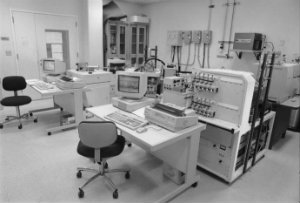 Samples can either be analyzed from natural abundance or, on some instances, enriched sources. Front-ends for the IRMS's include: two automated carbonate devices, and a full suite of continuous flow peripheral devices. This facility is open to the UCSC community and is a vital research resource for many faculty, researchers and students in the Earth & Planetary Sciences Department. The laboratory is supported by the National Science Foundation, the UCSC Office of Research, the Division of Physical and Biological Sciences, the Earth and Planetary Sciences Department, and the Ocean Sciences Department.
Samples can either be analyzed from natural abundance or, on some instances, enriched sources. Front-ends for the IRMS's include: two automated carbonate devices, and a full suite of continuous flow peripheral devices. This facility is open to the UCSC community and is a vital research resource for many faculty, researchers and students in the Earth & Planetary Sciences Department. The laboratory is supported by the National Science Foundation, the UCSC Office of Research, the Division of Physical and Biological Sciences, the Earth and Planetary Sciences Department, and the Ocean Sciences Department.
Geochronology
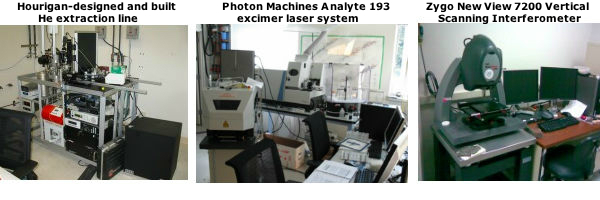
The Geochronology and Tectonic Processes group maintains a complete set of instrumentation and procedures for measuring U-Th/He thermochronometry and U-Pb age dating. This includes the Hourigan-designed, built, and coded, fully automated helium extraction line, and a Photon Machines Analyte 193 excimer laser system, which can be connected to both the He extraction line and the ElementXR for spatially-resolved grain analyses. A Zygo New View 7200 Vertical Scanning Interferometer is used for depth profiling and analysis of pit morphology.
The Surface Processes group in the department of Earth and Planetary Sciences maintains a cosmogenic isotope preparation lab for extraction of 10Be and 26Al for acceleration mass spectrometry measurement. Facilities include sample digestion equipment (open beaker, microwave and bombs), heated sonicating baths for leaching, and all necessary lab ware and clean room laboratory space.
X-ray Diffraction
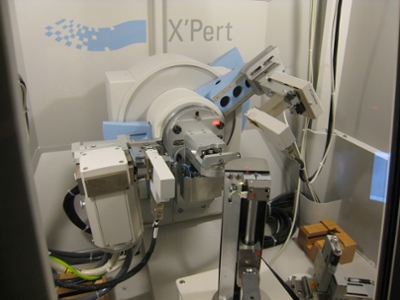
The department maintains a PANalytical PW3040/60 X'Pert PRO MPD X-Ray diffractometer for characterization of powdered crystalline materials. The instrument uses a 3kW ceramic PW3373/10 LFF X-Ray tube with a Cu anode. The X'celerator detector, implements the latest RTMS (Real Time Multiple Strip) X-ray detection technology and allows data collection at rates about 100 times faster than conventional single-point counters.The instrument is outfitted with adjustable slits for incident and diffracted beams that balance the needs of resolution, peak intensity and background minimization. The instrument is suited for qualitative and quantitative analysis of structures, phases, preferred crystal orientations (texture), and other structural parameters, such as average grain size, crystallinity, strain, and crystal defects.
Further questions regarding XRD lab use or capabilities of the XRD instrument, contact The Department of Earth and Planetary Sciences Technical Staff
An instrument demo from Malvern Panalytical is available here.
Laser Diffraction Particle Analysis
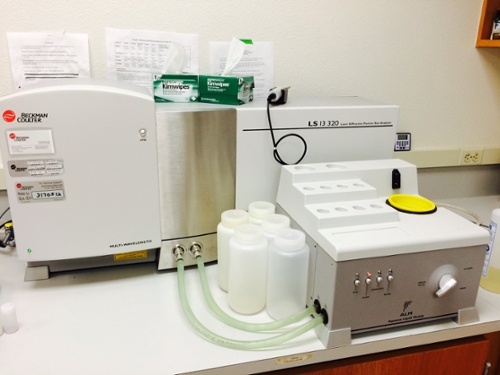
Laser diffraction particle size analysis measures particle size using the classic Mie theory of light scattering and Beckman Coulter exclusive PIDS technology, offering high resolution, reproducibility and unsurpassed accuracy. This instrument is capable of providing size distribution in volume, number and surface area in one measurement, with an overall sizing range from 17 nm to 2000 µm.
The department currently maintains a Beckman Coulter LS 13320. This laser diffraction systems is optimized for diverse applications such as soil sediment analysis and powder analysis. The system features automodal analysis, meaning users are not required to guess a distribution shape prior to analysis. The LS 13320 boasts are very large number of detectors which provides high resolution data and accurate results.
